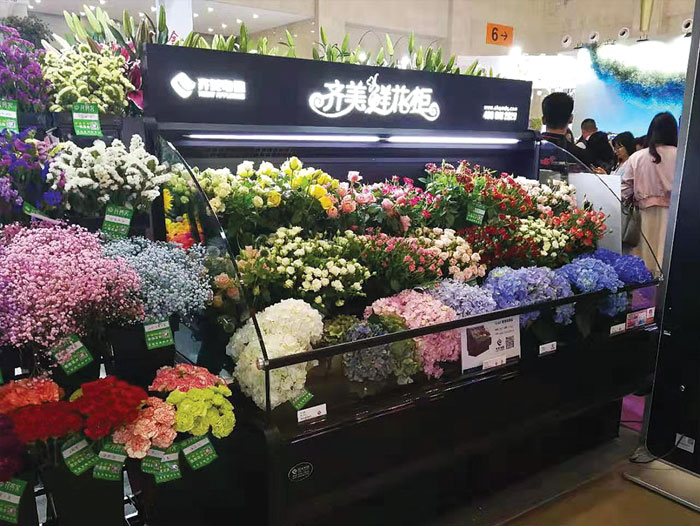Emerging Floral in China
September 10, 2019 | 4 min to read

Do consumers in China buy floral products at supermarkets the way shoppers in the United States purchase flowers?
The floral world in China is expanding and becoming more like the U.S. market. While mass market floral sales in China in supermarkets and convenience stores have yet to be developed, e-commerce companies are increasingly playing a significant role in delivering fresh-cut flower bouquets to consumers in China. Monthly or weekly subscription delivery service is popular with floral consumers as a lifestyle commitment to enhance one’s personal space at work or home.
Supply Chain Growing Pains
One of the main issues facing floral sales growth in China is an underdeveloped supply chain logistics system, including maintaining a post-harvest cold chain for flowers. Refrigeration — as in refrigerated floral coolers at point of purchase or pick up — is just beginning to be utilized. Also, flower food packets attached to each bouquet, common to consumers in the U.S., are not yet widely distributed, despite the presence of Chrysal and Floralife in China for more than 10 years.
Issues relating to floral distribution and transport linked to wholesalers, e-commerce fulfillment centers, and importers/exporters, especially floral-specific refrigerated trucks and cold storage, are still being addressed. The complexity of this issue can be attributed to China having a very large geographical area to cover, similar to the U.S. Solutions are needed, and significant investment is being made, to overcome the challenge of establishing a countrywide network to supply quality floral product to consumers. In the U.S., it is no small feat of supply chain coordination that millions of floral bouquets or bunches, let alone pre-made floral arrangements, are shipped weekly from Miami throughout the U.S. to distribution warehouses, wholesalers or mass-market outlets.

Efficiency And Productivity
Recently, following the International Floriculture Expo and Conference, FLORAL BUSINESS assisted with coordinating a day for several large bouquet manufacturers in Miami to host “Rick,” their first visitor from China. An interesting exchange of communication resulted in recognizing that in both countries, the U.S. and China, the increasing cost of labor is giving rise to more focus on automation, labor saving technology, and an operations management approach that requires ongoing changes to increase efficiency and productivity. During the past 25 years, as China’s flower industry has mainly focused on improving or expanding flower production, little attention was given to the professional management of floral distribution and marketing. It was an eye-opening moment for Rick to see how millions of flower stems are handled through a system of conveyor belts, forklifts, and palletized boxes and water-filled buckets, as part of an efficient system with quality control supervision to ultimately distribute top-quality floral product to U.S. consumers daily. Reflecting after the tour, Rick realized that China has the components of technology, labor supply and flowers, but not the know-how to manage and coordinate a smooth and efficient flower-handling and supply chain system. This, despite the country’s capability to deliver an e-commerce order for a flower arrangement to consumers on their birthday, to be located and identified as they walk to work on a busy street in Shanghai!
Flower Supply And Imports
The floral consumer in China is becoming more discerning and demanding in terms of flower quality, colors, textures, appearance and vase life. Consumers want more variety and different varieties. Today, Chinese flower farmers and flower companies produce nearly 18 billion stems for a purchasing population of approximately 1.2 billion consumers. Optimally, this averages about 15 stems per person annually. In contrast, in Japan, where the flower industry is a mature market, floral consumption averages between 30 to 40 stems per person. During the past four years, flower imports by China have increased rapidly to satisfy the consumer demand for unique, high quality flowers that presently are unavailable in China. Imports are still a small part of overall consumption but, currently totaling more than USD $65 million dollars and continuing to increase. Most flowers are imported to fill demand during peak holiday season. Top exporting countries are Ecuador, Thailand, Vietnam, Holland and Kenya. To date, floral consumption and distribution have not penetrated through to the supermarket channel in China, but this is anticipated, especially in second and third tier cities, where the majority of middle-class consumers live. These consumers are characterized as impulse buyers. It is forecasted that when flowers are readily accessible in highly merchandized mixed bouquets and bunches to middle class consumers in China, as available in U.S. supermarkets, the supply of flowers needed to satisfy demand in China will exceed 40 to 60 billion stems annually. Domestic production will be unable to supply this level of demand, at least in the coming 10 years. Consequently, there is an increasing opportunity for flower exports to China, in addition to technology and management services to develop this market.
Today, flowers are a part of the everyday lives of consumers in China. They are gifted to friends and family and purchased for oneself. Flower channels of distribution will continue to proliferate. Flowers will flow to consumers from e-commerce sites for one-time sales or subscription sales. And the flow will continue via traditional retail flower shops, event planners and wholesalers/importers. Also, the mass market segment will capture an ever-greater share of the market as seen in the U.S. The hallmarks of this inevitable development will be convenience, quality, service and pricing. Fb

Heidi Wernett, Ph.D., is an American entrepreneur and international floriculture industry expert. A noted speaker and authority on floriculture trends in the Indo-Asia Pacific region, she has more than 30 years of business experience in Asia. Wernett is president of China Horticultural Business Services, LLC, based in Kunming, China and can be reached at hwernett@gmail.com.
